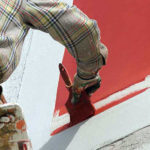Content
- 1 The need for finishing the base
-
2 Types of basement tiles for the facade
- 2.1 Clinker
- 2.2 Porcelain Tiles
- 2.3 Polymer sand, hyper pressed tile
- 2.4 Flexible tile
- 2.5 Natural and artificial stone
- 2.6 Siding
- 3 The nuances of laying tiles for the basement
- 4 Video
- 5 A photo
One of the most popular finishing materials is the basement tile for the facade, which has some advantages over other types of finishes. Its popularity is due to many reasons. Firstly, you can forget about the constant repainting of the walls. Secondly, the outer cladding is able to contain the damaging effects of weather conditions on the walls of the building. Thirdly, it is possible to significantly insulate wall surfaces. In addition, a house with such a cladding looks very aesthetically pleasing.
Today, manufacturers offer a wide selection of materials that differ in their technical qualities, operating methods. There are a lot of types of facing material and thanks to each of them the building can look unique and beautiful.
The need for finishing the base
The decoration of the protruding base must be done before laying the facade cladding in order to hide the upper mounting shelf of the ebb for decoration. Basement tiles are considered to be the most suitable option for this among other facing materials. It is also quite easy to mount, which does not require a lot of time. In the market of building materials, various types of cladding are offered. Before deciding on the material for your home, you need to take into account some points, namely:
- the protruding base should be protected by reflux to prevent moisture from entering;
- flexible tiles with the smallest thickness, you can glue the top of the concrete;
- brickwork can maximize the building;
- insulating material is laid inside the frames on which the panels, siding or corrugated board are fastened to reduce heat loss;
- The frame system is easiest to repair and update at any time during construction.



Types of basement tiles for the facade
Manufacturers offer various types of basement cladding materials that will help to renovate the house and choose the option that suits the design and budget. We offer you to learn about the most popular of similar materials.
Clinker
Clinker tile is a fairly popular building material for facing the basement. It is presented in the form of tiles or masonry. The fame of such a material is determined by its strength and durability. Clinker perfectly tolerates any weather conditions, does not absorb moisture and perfectly waterproofs the building.
There are several types of material:
- hand molding;
- produced by machine pressing.
These materials practically do not differ from each other, but, nevertheless, they are distinguished by density. During the pressing process, the clinker is given increased density, due to which cladding characteristics such as frost resistance, strength, and long service life are improved. When deciding to make the cladding of the basement with clinker, it is worth giving preference to the material that is made by machine.



Porcelain Tiles
Unlike clinker tiles, porcelain tiles are rarely used for the exterior cladding of a house. When choosing ceramics, it is worth paying attention to its operating conditions, since in order to finish the basement of the building, it is necessary that the material is sufficiently frost-resistant. On the packaging of the material you can find the designation in the form of a snowflake.
Ceramic tile has some disadvantage in the form of instability before impacts. Also, such a tile costs a lot, but it is presented on the market in a wide variety of colors, shapes and textures.
Polymer sand, hyper pressed tile
Polymer sand tiles look like natural stone. According to the operating conditions, it, like the clinker, is very durable. A positive feature of such a tile is its fairly easy installation, since such a tile can be without problems to repair and install on the base of the house, not only thanks to glue, but also due to self-tapping screws.
Hyperpressed tiles are another type of facade decoration. In its characteristic features, it, like polymer sand, is similar to clinker tile. Its difference lies only in the smallest weight and the greatest strength. The main component in the manufacture of this tile are bulk materials that combine with water and binders.



Flexible tile
Flexible stone is a resin-based artificial material. The advantage of flexible tiles is that they can be laid on a plinth with a complex configuration. This building cladding is available in the form of tiles and rolls. When heated, the rolls can be folded in any way. Also, flexible stone can be used not only for facade decoration, but also for interior wall decor. It is simply dismantled and cut into the necessary pieces.



Natural and artificial stone
Natural stone is an expensive, but very durable material, which also will last quite a long time. The advantages of natural stone are considered to be greater decorativeness and longer service life. Also, natural stone is difficult to damage, as it is environmentally friendly. The disadvantages of this finish are the high cost of the stone, the light weight and the complexity of the installation. The size of the basement tile can be arbitrary. During the laying of the facade, it is worthwhile to correctly select each stone to each other. Stone decoration sometimes can not be combined with the cladding of the whole house, so you should choose it based on the existing design of the whole house.
The composition of the artificial stone includes sand, cement and many other additives that improve the aesthetics of the building and operating conditions. You can choose this material with any shade and shape. But, such a stone has a major drawback - it does not absorb moisture well. If the artificial stone is laid without observing the appropriate technology, after severe frosts it can be destroyed. In order to prevent the bassoon from freezing, it should be soaked in warm water before installation.


Siding
With a small budget, facing from the basement siding is perfect for home decoration. This material is very popular when decorating facades from the outside. Also, the largest selection of materials for finishing siding for the basement. In addition to low tide and corners, manufacturers produce such a type of material as: start, finish and clammer for unobtrusive bonding of tiles.
Large-format tiles for the basement and facade are perfect for cottages. It is also called fiber cement panels, in the manufacture of which nanotechnology is used with the introduction of special capsules that work like a sponge into the tiles. They are able to absorb moisture and return it back. Thus, the optimum moisture in the finishing material can be maintained, because of which it can withstand enough any weather changes.



The nuances of laying tiles for the basement
The main problem of the basement of the building with tiles is the large size of the horizontal row. Even experienced professionals are not easy enough to evenly lay the basement row. It is because of this that it is worth paying attention to the initial series. It is laid along the established line. A long rail, which is used as the base for the first row, should be attached to the base level. When facing the upper part, the rail should be removed and the remaining tiles laid.
It is also worth paying attention to such nuances as:
- selection of glue that provides styling and durability of the finish. Conventional tile adhesive in this case will not work - you need the most durable adhesive, resistant to moisture and frost. You can also use waterproofing mixtures when laying plates;
- reinforcing mesh is also necessary for the integrity of the cladding material. Even if one tile is poorly connected, this grid will hold it. In addition, it is an excellent adhesion of tiles to the building;
- low tide - helps prevent rain, water from getting on the base. In this case, the tile does not crack during frost and will be resistant to moisture. Ebb is mainly used when installing a material such as artificial stone.



Subject to all the nuances of laying tiles for the basement, it will retain its aesthetic appearance for a long time and decorate the facade of the house.
With the help of the plinth, various methods can be used to decorate a house on the basis of its budget, laid down in building materials, the style of architecture of the building, and the wishes of the owner of the house. It is recommended to focus on the weight of the tiles, their thickness or cost.
Video
The video clip shows the process of laying tiles on the base.
A photo
To imagine how the basement of a house can be designed, we suggest you look at a selection of photos.























-
 Wallpaper 3D: stylish design - good mood
Wallpaper 3D: stylish design - good mood
-
 Choose a wallpaper for the bedroom: types, color, photo
Choose a wallpaper for the bedroom: types, color, photo
-
 Finishing the facade of the house using modern materials, its types and photo examples
Finishing the facade of the house using modern materials, its types and photo examples
-
 What types of windows are found on building facades?
What types of windows are found on building facades?
-
 The use of facing stone for facade decoration
The use of facing stone for facade decoration
-
 The choice of paint for painting building facades
The choice of paint for painting building facades
-
 Glass facades, types and photos
Glass facades, types and photos
-
 Popular materials for facade cladding, which one is better
Popular materials for facade cladding, which one is better
-
 Soaring suspended ceiling
Soaring suspended ceiling
-
 What are the panels for decorating the facade of a private house, their types and recommendations
What are the panels for decorating the facade of a private house, their types and recommendations
-
 Bad or good cotton carpets, sorted out the issue
Bad or good cotton carpets, sorted out the issue
-
 Furniture spanbond: pros and cons
Furniture spanbond: pros and cons
New publications are published daily on our channel in Yandex. Zen
Go to Yandex. Zen





